The ready to eat canned tuna market is projected to grow from USD 5.6 billion in 2025 to USD 10.1 billion by 2035, indicating strong global expansion. A key trend shaping the market is the rising preference for high protein, ready to serve meal components, driven by busy lifestyle patterns and increased awareness of balanced dietary intake. Consumers are gravitating toward tuna products that offer convenience without compromising on nutritional density. Demand is also increasing for premium and sustainably sourced tuna, as transparency in fishing practices and origin labeling becomes a major purchasing factor in both retail and foodservice channels.
Manufacturers are expanding flavor-enhanced and ready seasoned product lines to broaden appeal across varied culinary preferences. Packaging innovation continues to advance, with easy open cans, pouches, and single serve formats gaining adoption to match on the go consumption habits. E commerce and direct to consumer grocery delivery platforms are influencing distribution strategies, making product freshness assurance and reliable fulfillment capabilities more important. Retailers are expanding private label canned tuna programs to offer value based alternatives while maintaining product quality benchmarks. Technology advancement influences market evolution through integration of advanced packaging systems, preservation technologies, and enhanced processing methods that improve product shelf life and consumer satisfaction. Manufacturers focus on developing tuna solutions that accommodate varying flavor preferences, packaging sizes, and price points while maintaining product quality throughout extended distribution periods. The ready-to-eat canned tuna market demonstrates strong growth fundamentals driven by expanding consumer demand, retail infrastructure development, and increasing preference for convenient protein sources across multiple demographic segments and consumption occasions.
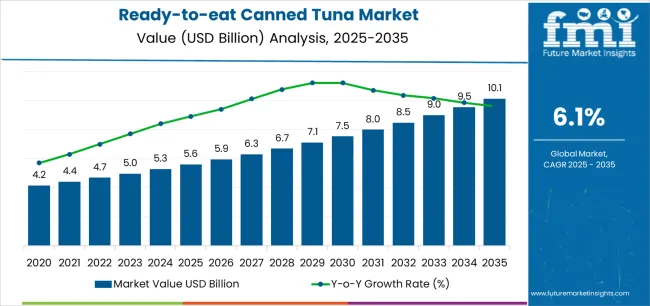
The first half of the decade (2025-2030) will witness market growth from USD 5.6 billion to approximately USD 7.5 billion, adding USD 1.9 billion in value, representing 44% of the total forecast period expansion. This phase will be characterized by rapid adoption of premium product formats, driven by retail modernization programs and increasing demand for high-quality canned seafood across consumer segments.
The latter half (2030-2035) will experience continued growth from USD 7.5 billion to USD 10.1 billion, representing an addition of USD 2.6 billion or 56% of the decade's expansion. This period will be defined by mass market penetration of premium canned tuna products, integration with modern retail systems, and seamless connectivity with evolving consumer preferences and purchasing patterns.
| Period | Primary Revenue Buckets | Share | Notes |
|---|---|---|---|
| Today | In water varieties (retail, foodservice) | 62% | Traditional preferences, health-conscious consumers |
| In oil products | 28% | Premium positioning, flavor enhancement | |
| Specialty & flavored varieties | 10% | Gourmet applications, premium segments | |
| Future (3-5 yrs) | Premium in water systems | 58-61% | Health optimization, clean label trends |
| Enhanced oil-based products | 22-25% | Flavor innovation, culinary applications | |
| Catering industry applications | 18-21% | Foodservice expansion, commercial kitchens | |
| Supermarket channels | 35-38% | Retail dominance, private label growth | |
| Department store distribution | 15-18% | Premium positioning, gift segments | |
| Online sales platforms | 12-15% | E-commerce growth, direct-to-consumer | |
| Specialty retail channels | 8-11% | Gourmet stores, organic outlets |
At-a-Glance Metrics
| Metric | Value |
|---|---|
| Market Value (2025) | USD 5.6 billion |
| Market Forecast (2035) | USD 10.1 billion |
| Growth Rate | 6.1% CAGR |
| Leading Type | In Water |
| Primary Application | Catering Industry |
The market demonstrates strong fundamentals with in water tuna products capturing a dominant share through health-conscious positioning and retail application optimization. Catering industry applications drive primary demand, supported by increasing foodservice activity and commercial kitchen expansion initiatives. Geographic distribution remains concentrated in developed markets with established retail infrastructure, while emerging economies show accelerating adoption rates driven by modern retail development programs and rising protein consumption.
Primary Classification: The market segments by type into in water and in oil variants, representing evolution from traditional preservation methods to sophisticated flavor-enhanced processing technologies for comprehensive consumer preference optimization.
Secondary Classification: Application segmentation divides the market into catering industry, supermarkets, department stores, online sales, and others, reflecting distinct requirements for packaging formats, distribution channels, and consumer accessibility specifications.
Tertiary Classification: End-use segmentation covers retail consumers, foodservice operators, commercial kitchens, institutional buyers, and specialty food providers, while distribution channels span direct retail sales, food distributors, and specialized seafood suppliers.
Regional Classification: Geographic distribution covers North America, Latin America, Western Europe, Eastern Europe, East Asia, South Asia Pacific, and Middle East & Africa, with developed markets leading consumption while emerging economies show accelerating growth patterns driven by modern retail infrastructure development programs.
The segmentation structure reveals product progression from traditional canned preservation toward sophisticated flavor-enhanced processing systems with enhanced convenience capabilities, while application diversity spans from household consumption to specialized commercial food preparation requiring quality-assured protein solutions.
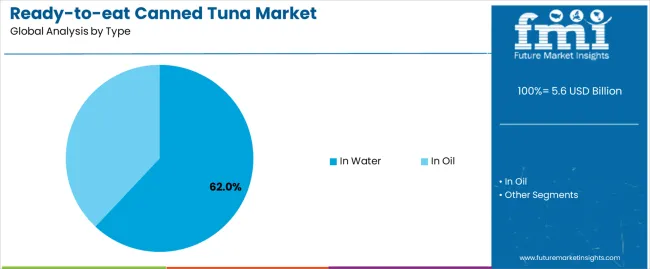
Market Position: In water canned tuna products command the leading position in the ready-to-eat canned tuna market with 62% market share through proven health positioning, including reduced caloric content, clean nutritional profiles, and consumer health optimization that enable food buyers to achieve dietary goals across diverse household and commercial environments.
Value Drivers: The segment benefits from consumer preference for health-conscious protein options that provide essential nutrients, operational convenience, and dietary flexibility without requiring additional preparation steps. Advanced processing features enable enhanced flavor retention, texture preservation, and integration with existing meal planning systems, where nutritional quality and preparation simplicity represent critical consumer requirements.
Competitive Advantages: In water canned tuna products differentiate through proven health benefits, versatile application characteristics, and compatibility with established dietary programs that enhance meal planning effectiveness while maintaining optimal nutritional standards suitable for diverse consumption occasions.
Key market characteristics:
In oil canned tuna products maintain a 28% market position in the ready-to-eat canned tuna market due to their premium positioning advantages and enhanced flavor application benefits. These products appeal to consumers requiring rich taste profiles with enhanced culinary versatility for gourmet meal preparation. Market growth is driven by premium food segment expansion, emphasizing flavor-enhanced protein solutions and culinary excellence through optimized taste enhancement designs.
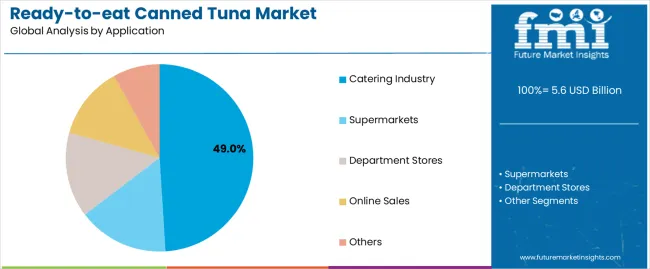
Market Context: Catering industry applications demonstrate strong growth in the ready-to-eat canned tuna market, holding a 49% share due to the widespread adoption of convenient protein solutions and an increasing focus on commercial food preparation, menu diversification, and foodservice applications that maximize operational efficiency while maintaining food quality standards.
Appeal Factors: Catering operators prioritize product consistency, supply chain reliability, and integration with existing kitchen infrastructure that enables coordinated meal preparation across multiple service occasions. The segment benefits from substantial foodservice industry investment and commercial kitchen modernization programs that emphasize acquisition of high-quality protein products for menu optimization and operational applications.
Growth Drivers: Commercial foodservice programs incorporate canned tuna as essential components for menu operations, while institutional catering increases demand for protein solutions that comply with nutritional standards and minimize preparation complexity.
Market Challenges: Varying menu requirements and portion size complexity may limit product standardization across different foodservice facilities or operational scenarios.
Application dynamics include:
Supermarket applications capture 35% market share through consumer retail requirements in grocery chains, retail outlets, and food merchandising applications. These channels demand high-turnover products capable of supporting consumer purchasing patterns while providing quality assurance and competitive pricing capabilities.
Department store applications account for 16% market share, including premium retail locations, gift food sections, and specialty merchandise operations requiring high-quality canned products for upscale consumer positioning and premium food merchandising.

Market Context: Retail consumers dominate the market with a 40% share, reflecting the primary demand source for ready-to-eat canned tuna in household consumption and meal preparation.
Business Model Advantages: Retail Consumer applications provide direct market demand for standardized protein products, driving volume production and cost optimization while maintaining quality consistency and nutritional value requirements.
Operational Benefits: Retail Consumer applications include meal planning optimization, convenience enhancement, and nutritional assurance that drive consistent demand for canned tuna products while providing access to latest processing technologies.
| Category | Factor | Impact | Why It Matters |
|---|---|---|---|
| Driver | Health consciousness expansion & protein demand growth (nutrition awareness, fitness trends) | ★★★★★ | Growing health market requires convenient protein solutions with enhanced nutritional profiles and quality properties proven effective across dietary applications. |
| Driver | Convenience food adoption & lifestyle changes (busy schedules, meal preparation simplification) | ★★★★★ | Transforms food consumption from "traditional cooking" to "convenience optimization"; operators that offer ready-to-eat solutions and preparation features gain competitive advantage. |
| Driver | Retail modernization & distribution expansion (supply chain optimization, channel development) | ★★★★☆ | Modern retail facilities need diverse, shelf-stable protein products; demand for convenient and accessible food solutions expanding addressable market. |
| Restraint | Raw material cost fluctuations & supply chain pressures (fishing quotas, processing costs) | ★★★★☆ | Smaller food companies defer premium product development; increases price sensitivity and slows advanced product adoption in cost-conscious markets. |
| Restraint | Alternative protein competition & dietary trend shifts (plant-based options, fresh seafood preference) | ★★★☆☆ | Alternative protein sources offer different nutritional profiles and sustainability positioning, potentially limiting canned tuna adoption in health-conscious segments. |
| Trend | Premium product development & flavor innovation (gourmet varieties, specialty processing) | ★★★★★ | Advanced flavor properties, quality optimization, and culinary enhancement transform offerings; product innovation and taste enhancement become core value propositions. |
| Trend | E-commerce integration & direct-to-consumer sales (online platforms, subscription services) | ★★★★☆ | Smart distribution systems for specific demographics and purchasing patterns; specialized delivery and targeted marketing capabilities drive competition toward connected solutions. |
The ready-to-eat canned tuna market demonstrates varied regional dynamics with Growth Leaders including China (8.2% growth rate) and India (7.6% growth rate) driving expansion through retail infrastructure development and consumer dietary modernization initiatives. Steady Performers encompass Germany (7.0% growth rate), Brazil (6.4% growth rate), and developed regions, benefiting from established food retail systems and protein consumption growth. Mature Markets feature United States (5.8% growth rate), United Kingdom (5.2% growth rate), and Japan (4.6% growth rate), where convenience food advancement and retail optimization requirements support consistent growth patterns.
Regional synthesis reveals East Asian markets leading adoption through consumer modernization and protein consumption development, while North American countries maintain steady expansion supported by convenience food advancement and retail infrastructure investment. European markets show strong growth driven by health-conscious applications and premium product integration trends.
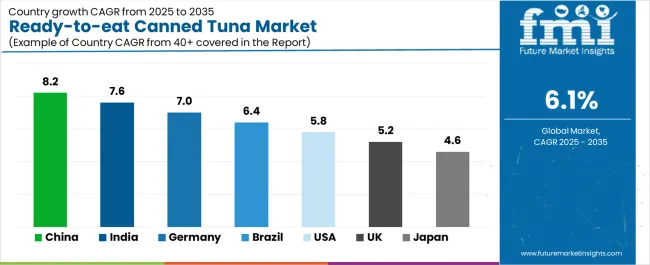
| Region/Country | 2025-2035 Growth | How to win | What to watch out |
|---|---|---|---|
| China | 8.2% | Focus on premium health-oriented products | Regulatory changes; local competition |
| India | 7.6% | Lead with convenient protein solutions | Import restrictions; cultural preferences |
| Germany | 7.0% | Provide premium organic varieties | Over-regulation; lengthy approvals |
| Brazil | 6.4% | Offer value-oriented products | Currency fluctuations; import duties |
| USA | 5.8% | Push convenience innovation | Health regulations; scaling challenges |
| UK | 5.2% | Focus on premium applications | Economic impacts; Brexit effects |
| Japan | 4.6% | Emphasize quality manufacturing | Traditional preferences; adoption rates |
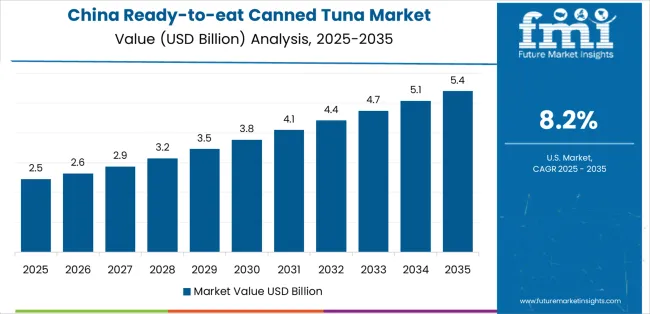
China establishes fastest market growth through aggressive retail infrastructure development programs and comprehensive consumer dietary modernization, integrating ready-to-eat canned tuna products as standard options in supermarket chains and modern retail outlets. The country's 8.2% growth rate reflects urbanization initiatives promoting convenient food consumption and domestic protein diversification that mandate use of shelf-stable seafood products in urban households and commercial food operations. Growth concentrates in major urban centers, including Beijing, Shanghai, and Guangzhou, where retail development showcases integrated food distribution systems that appeal to consumers seeking convenient protein options and meal preparation applications.
Chinese retailers are developing cost-effective protein solutions that combine domestic distribution advantages with international quality features, including enhanced flavor profiles and improved packaging capabilities. Distribution channels through supermarket chains and food retail integrators expand market access, while consumer income growth supports adoption across diverse demographic and urban segments.
Strategic Market Indicators:
In Mumbai, Delhi, and Bangalore, retail facilities and food distribution operators are implementing ready-to-eat canned tuna products as standard merchandise for consumer convenience and dietary optimization applications, driven by increasing urbanization and dietary modernization programs that emphasize importance of convenient protein capabilities. The market holds a 7.6% growth rate, supported by retail modernization initiatives and consumer dietary programs that promote shelf-stable protein products for urban and professional households. Indian consumers are adopting canned products that provide consistent nutritional benefits and convenience features, particularly appealing in urban regions where meal preparation optimization and dietary quality represent critical lifestyle requirements.
Market expansion benefits from growing retail capabilities and international product partnerships that enable domestic distribution of quality canned seafood for consumer and commercial applications. Product adoption follows patterns established in convenience foods, where quality and convenience drive purchasing decisions and consumption deployment.
Market Intelligence Brief:
Germany remains a premium leader in the canned tuna market, benefiting from advanced food processing technologies and robust retail infrastructure. With a growth rate of 7.0%, Germany’s retail sector is characterized by its focus on high-quality, organic-certified canned tuna products. Food processing centers, particularly in regions like Bavaria and North Rhine-Westphalia, incorporate premium products into their grocery systems, ensuring that consumer demand for health-conscious and sustainable seafood solutions is met. The integration of organic and sustainable sourcing strategies in German retail systems underscores the market's demand for premium, compliant food offerings.
German retailers prioritize product quality and EU compliance in food procurement, creating demand for premium products with advanced features, including organic certification and quality management systems. The market benefits from established retail infrastructure and willingness to invest in premium food products that provide long-term nutritional benefits and compliance with international food standards.
Market Intelligence Brief:
Brazil’s growth in the canned tuna market is underpinned by expanding retail modernization and an increasing focus on accessible, protein-rich food options. With a growth rate of 6.4%, Brazil’s urban areas like São Paulo and Rio de Janeiro are seeing rising demand for convenient food solutions that align with busy lifestyles. The retail sector's focus on cost-effective protein products ensures that canned tuna meets the dietary needs of both households and businesses. As Brazil’s middle class grows, the demand for affordable yet nutritious food products like canned seafood is on the rise.
Market dynamics focus on cost-effective protein solutions that balance nutritional performance with affordability considerations important to Brazilian consumers. Growing retail industrialization creates continued demand for convenient food products in new commercial infrastructure and consumer modernization projects.
Strategic Market Considerations:
United States establishes market leadership through comprehensive retail programs and advanced food distribution infrastructure development, integrating canned tuna products across grocery and foodservice applications. The country's 5.8% growth rate reflects established consumer relationships and mature convenience food adoption that supports widespread use of shelf-stable protein products in retail and commercial facilities. Growth concentrates in major metropolitan areas, including California, Texas, and New York, where food retail showcases mature deployment that appeals to consumers seeking proven convenience capabilities and meal preparation optimization applications.
American food providers leverage established distribution networks and comprehensive marketing support capabilities, including product promotion programs and consumer education support that create brand relationships and operational advantages. The market benefits from mature regulatory standards and nutritional requirements that support canned product use while encouraging innovation advancement and convenience optimization.
Market Intelligence Brief:
The United Kingdom’s market for canned tuna is seeing steady growth, with a focus on integrating high-quality products into premium retail applications. With a growth rate of 5.2%, the UK’s retail and grocery systems are increasingly prioritizing high-quality, sustainably sourced canned seafood products. Retailers across England, Scotland, and Wales are enhancing their offerings to meet the growing demand for health-conscious, sustainable food options. The country’s emphasis on product reliability and nutritional integrity continues to drive consumer trust and retail success.
UK food providers prioritize product reliability and retail compatibility in food procurement, creating demand for validated products with proven quality features, including nutritional monitoring integration and quality management systems. The market benefits from established retail infrastructure and quality requirements that support food product adoption and consumer effectiveness.
Market Intelligence Brief:
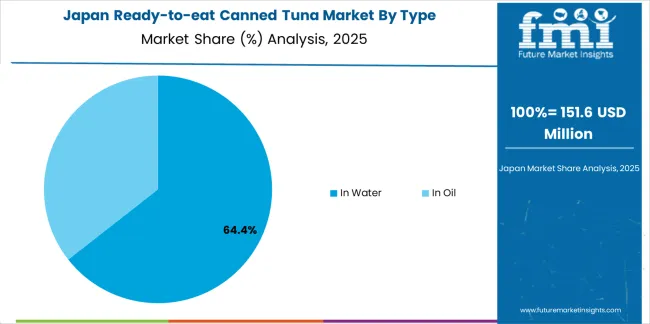
Premium canned tuna market in Japan is driven by growing consumer demand for high-quality, convenient protein sources. With a growth rate of 4.6%, Japan’s food retail sector is seeing a shift towards premium and sustainable seafood options. The country’s sophisticated food processing technologies ensure that canned tuna products meet the highest standards of quality and nutritional value. Retailers in Tokyo and Osaka, key consumer hubs, are integrating premium canned seafood into their offerings to meet the demands of health-conscious consumers.
Market dynamics focus on high-quality canned solutions that meet Japanese quality standards and dietary effectiveness requirements important to consumers. Advanced food retail adoption creates continued demand for premium canned products in consumer lifestyle infrastructure and dietary modernization projects.
Strategic Market Considerations:
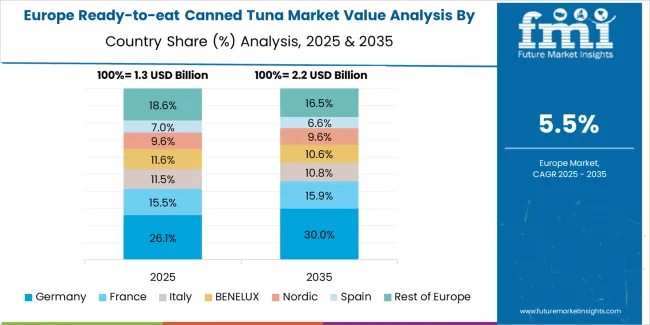
The European ready-to-eat canned tuna market is projected to grow from USD 1,156.8 million in 2025 to USD 1,847.2 million by 2035, registering a CAGR of 4.8% over the forecast period. Germany is expected to maintain its leadership position with a 38.4% market share in 2025, supported by its advanced retail infrastructure and major food distribution centers.
United Kingdom follows with a 26.7% share in 2025, driven by comprehensive convenience food programs and premium product development initiatives. France holds a 16.9% share through specialized retail applications and food quality compliance requirements. Italy commands a 9.2% share, while Spain accounts for 5.6% in 2025. The rest of Europe region is anticipated to gain momentum, expanding its collective share from 3.2% to 3.5% by 2035, attributed to increasing convenience food adoption in Nordic countries and emerging retail facilities implementing modern food distribution programs.
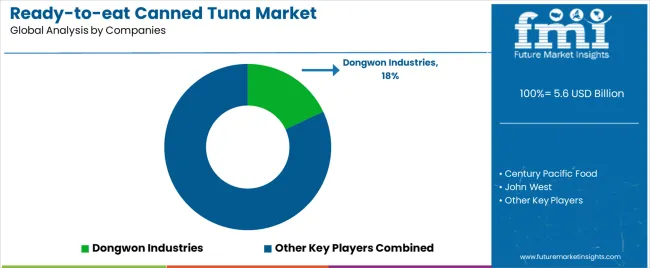
| Stakeholder | What they actually control | Typical strengths | Typical blind spots |
|---|---|---|---|
| Global brands | Distribution reach, broad product catalogs, brand recognition | Wide availability, proven quality, multi-region support | Product refresh cycles; consumer dependency on brand validation |
| Regional processors | Processing R&D; local sourcing; enhanced flavor technologies | Latest processing first; attractive ROI on quality effectiveness | Distribution density outside core regions; scaling complexity |
| Local specialists | Regional compliance, fast delivery, nearby customer support | "Close to customer" support; pragmatic pricing; local preferences | Technology gaps; talent retention in consumer service |
| Premium providers | Complete retail programs, brand integration, quality monitoring | Lowest operational risk; comprehensive support | Service costs if overpromised; product obsolescence |
| Value specialists | Cost optimization, volume production, efficient processing | Win price-sensitive segments; flexible configurations | Scalability limitations; narrow market focus |
| Item | Value |
|---|---|
| Quantitative Units | USD 5.6 billion |
| Type | In Water, In Oil |
| Application | Catering Industry, Supermarkets, Department Stores, Online Sales, Others |
| End Use | Retail Consumers, Foodservice Operators, Commercial Kitchens, Institutional Buyers, Specialty Food Providers |
| Regions Covered | North America, Latin America, Western Europe, Eastern Europe, East Asia, South Asia Pacific, Middle East & Africa |
| Countries Covered | China, India, Germany, Brazil, United States, United Kingdom, Japan, Canada, France, Australia, and 25+ additional countries |
| Key Companies Profiled |
Dongwon Industries, Century Pacific Food Inc., John West Foods, Princes Foods |
| Additional Attributes | Dollar sales by type and application categories, regional adoption trends across East Asia, North America, and Western Europe, competitive landscape with food processing manufacturers and retail integrators, consumer preferences for convenience effectiveness and nutritional quality, integration with retail platforms and distribution systems, innovations in processing technology and flavor enhancement, and development of premium canned solutions with enhanced quality and consumer optimization capabilities. |
The global ready-to-eat canned tuna market is estimated to be valued at USD 5.6 billion in 2025.
The market size for the ready-to-eat canned tuna market is projected to reach USD 10.1 billion by 2035.
The ready-to-eat canned tuna market is expected to grow at a 6.1% CAGR between 2025 and 2035.
The key product types in ready-to-eat canned tuna market are in water and in oil.
In terms of application, catering industry segment to command 49.0% share in the ready-to-eat canned tuna market in 2025.






Full Research Suite comprises of:
Market outlook & trends analysis
Interviews & case studies
Strategic recommendations
Vendor profiles & capabilities analysis
5-year forecasts
8 regions and 60+ country-level data splits
Market segment data splits
12 months of continuous data updates
DELIVERED AS:
PDF EXCEL ONLINE
Canned Wet Cat Food Market Size and Share Forecast Outlook 2025 to 2035
Canned Food Packaging Market Size and Share Forecast Outlook 2025 to 2035
Canned Wine Market Size and Share Forecast Outlook 2025 to 2035
Canned Pet Food Market Analysis - Size and Share Forecast Outlook 2025 to 2035
Canned Food Packaging Industry Analysis in the United Kingdom Size and Share Forecast Outlook 2025 to 2035
Canned Fruits Market Size and Share Forecast Outlook 2025 to 2035
Canned Soup Market Size and Share Forecast Outlook 2025 to 2035
Canned Mackerel Market Analysis - Size, Share, and Forecast Outlook 2025 to 2035
Canned Anchovy Market Analysis - Size, Share, and Forecast Outlook 2025 to 2035
Canned Seafood Market Size, Growth, and Forecast for 2025 to 2035
Canned Alcoholic Beverages Market Analysis by Product Type, Distribution Channel, and Region Through 2035
Canned Legumes Market Insights – Protein-Packed Convenience Foods 2025 to 2035
Canned Meat Market Insights - Industry Growth & Demand 2025 to 2035
Canned Pasta Market Trends - Convenience & Consumer Preferences 2025 to 2035
Canned Mushroom Market Analysis by Nature, Product Type, Form, and End-Use Application Through 2035
Canned Salmon Market Analysis by Source, Species, Form, and Sales Channel Through 2035
Market Share Insights of Canned Food Packaging Providers
Analysis and Growth Projections for Canned Foods Business
Canned Vegetable Market Growth – Preservation & Industry Demand 2024-2034
Canned Sardine Market Growth – Sustainable Seafood & Industry Demand 2024-2034

Thank you!
You will receive an email from our Business Development Manager. Please be sure to check your SPAM/JUNK folder too.
Chat With
MaRIA